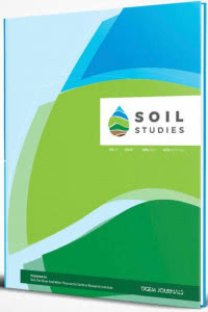Influence of Limited Water Stress on Yield and Fruit Quality of Melon under Soil-Borne Pathogens
Melon, soil-borne pathogens, quality, yield, water stress
Influence of Limited Water Stress on Yield and Fruit Quality of Melon under Soil-Borne Pathogens
___
- Alizadeh K A, Baghani J M, Haghnia G M (1999). Effect of deficit irrigation by drip and furrow systems on yield and quality of melon at Mashad, Iran. In: 17th 212 ICID International Congress on Irrigation and Drainage, 1:263-269.
- Al-Mefleh N K, Samarah N, Zaitoun S, Al-Majeed Al-Ghzawi A (2012). Effect of irrigation levels on fruit characteristics, total fruit yield and water use efficiency of melon under drip irrigation system. Journal of Food, Agriculture & Environment, 10: 540-545.
- Anonymous (2012). Agricultural structure and production. Goverment Statistic Institute of Prime Minister Publication. Available from: http://www.tuik.gov.tr (in Turkish).
- Ben-Yephet Y, Frank Z R (1985). Effect of soil structure on penetration by metham-sodium and of temperature on concentrations required to kill soil-borne pathogens. Phytopatlogy, 75: 403-406.
- Cabello M J, Castellanos M T, Romojaro F, Martinez-Madrid C, Ribas F (2009). Yield and quality of melon grown under different irrigation and nitrogen rates. Agricultural Water Management, 96: 866-874.
- Dogan E, Kirnak H, Berekatoglu K, Bilgel L, Surucu A (2008). Water stress imposed on muskmelon (Cucumis melo L.) with subsurface and surface drip irrigation systems under semi-arid climatic conditions. Irrigation Science, 26: 131-138.
- Ekinci M, Dursun A (2006). The effects of different mulch materials on plant growth some quality properties and yield in melon. VI. Vegetable Agriculture Symposium.pp. 320-324, 19- 22 September, K.Maraş, Turkey, (in Turkish).
- Estrella F S, Vargas-Garcia M C, Lopez M J, Moreno J (2003). Survival of Fusarium oxysporum f.sp. melonis on plant waste. Crop Production. 23 (2): 127-133.
- Fabeiro C, Martin De Santa Olalla F, De Juan J A (2002). Production of muskmelon (Cucumis melo L.) under controlled deficit irrigation in a semi-arid climate. Agricultural Water Management, 54: 93-105.
- Hartz T K (1997). Effects of drip irrigation scheduling on muskmelon yield and quality. Scientia Horticulturae, 69: 117- 122.
- Howell T A (2006). Challenges in increasing water use efficiency in irrigated agriculture. In: The Proceedings of International Symposium on Water and Land Management For Sustainable Irrigated Agriculture, April 4-8, Adana-Turkey.
- Howell T A, Cuenca R H, Solomon K H (1990). Crop yield response. Management of Farm Irrigation Systems (Ed. Hoffman et al.). ASAE, pp:311- 312.
- James L G (1988). Principles of farm irrigation system design. John Wiley and Sons. Inc, New York, p.543.
- Kirnak H, Higgs D, Kaya C, Tas I (2005). Effects 246 of irrigation and nitrogen rates on growth, yield, and quality of muskmelon in semiarid regions. Journal of Plant Nutrition, 28: 621-638. Lei T W, Xiao J, Wang J P, Liu Z Z, Li G Y, Zhang J G, Mao J M (2003). Experimental investigation into effects of drip irrigation with saline ground water on water use efficiency and quality of honeydew melons in Hetao region Inner Mongolia. Transactions of the Chinese Soc. Agric. Eng., 19: 80-84.
- Martyn R D, Gordon T R (1998). Compendium of cucurbit diseases. APS Press. 87: 14-15.
- Sensoy S, Ertek A, Gedik I, Kucukyumuk C (2007). Irrigation frequency and amount affect yield and quality of field-grown melon (Cucumis melo L.). Agricultural Water Management, 88: 269-274.
- Yıldırım O, Halloran N, Çavuşoğlu Ş, Şengül N (2009). Effects of different irrigation programs on the growth, yield, and fruit quality of drip-irrigated melon. Turkish Journal of Agriculture and Forestry, 33:243-255.
- Yücel S, Pala H, Sarı N, Abak K (1994). Determination of Fusarium oxysporum f.sp. melonis races in the East Mediterranean Region of Turkey and response of some melon genotypes to the disease. 9th Congress of the Mediterranean Phytopathological Union, pp:87-89, September 18-24, Kuşadası-Aydın, Türkiye.
- Yurtsever N(1984). Experimental statistics methods. Republic of Turkey, Ministry of Agriculture the Former General Directorate of Rural Service, Soil-Fertilizer Research Institute. Publication No.121, Techniques Publication No.56, Ankara, Turkey (in Turkish).
- ISSN: 2146-7072
- Yayın Aralığı: 2
- Yayıncı: Toprak Gübre ve Su Kaynakları Merkez Araştırma Enstitüsü
Arazi Toplulaştırmasında Kullanılan Arazi Kalite Derecelendirme Yöntemine Alternatif Yaklaşım
Orhan DENGİZ, Aziz ŞİŞMAN, Çoşkun GÜLSER, Yasemin ŞİŞMAN
Influence of Limited Water Stress on Yield and Fruit Quality of Melon under Soil-Borne Pathogens
Aynur ÖZBAHÇE, A. Fuat TARI, Seral YÜCEL, Oktay OKUR, Hüseyin PADEM
Farklı Organik Gübrelerin Mısır-Buğday Ekim Nöbetinde Buğdayın Verimine Bakiye Etkileri
Çay Tarımı Yapılan Topraklara Yönelik Faktör Analizi ve Jeoistatistik Uygulamaları: Rize İli Örneği
M. Arif ÖZYAZICI, Mustafa SAĞLAM, Orhan DENGİZ, Aylin ERKOÇAK
Meranın Otlatma Kapasitesi ve Botanik Kompozisyonuna Bazı Islah Yöntemlerinin Etkisi
Kuraklık Stresi Uygulanan Kavun Genotiplerinde Bazı Fizyolojik Değişimler Üzerine Araştırmalar
Sevinç KIRAN, Fatma ÖZKAY, Şebnem ELLİALTIOĞLU, Şebnem KUŞVURAN
Odun Sirkesinin Tarımsal Kullanım Potansiyelinin Araştırılması
Ayten NAMLI, M. Onur AKÇA, E. Burcu TURGAY, M. Reşat SOBA
Farklı Azotlu Gübreler ve Uygulama Zamanlarının Buğdayda Verim ve Verim Komponentlerine Etkileri
Mahmut TEPECİK, N. Tuba BARLAS, Emre İLKER
Mustafa SAĞLAM, Orhan DENGİZ, K. Çağatay SELVİ, E. Fatma GÜRSOY, Çağla ATASOY
